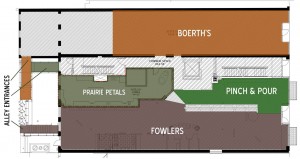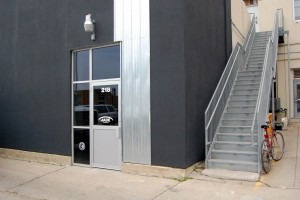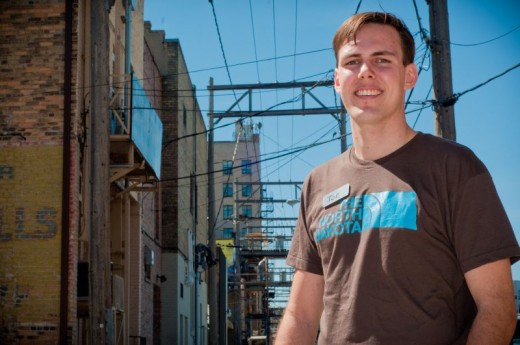It’s Saturday afternoon behind 300 Broadway in Downtown Fargo.
Outside, people are noshing on fancified food-truck fare, buying indie crafts and pushing trendily dressed tots in strollers.
But just a few steps away, inside the Fargo Theatre’s second-screen auditorium, 75 citizens want their first-ever Alley Fair served with a heaping side dish of education.
That’s where Doug Burgum comes in. Burgum is the entrepreneur and philanthropist who founded Kilbourne Group, a group committed to revitalizing downtown cores, starting with the Fargo metro area. And Doug’ son, Joe Burgum, was instrumental in developing Alley Fair.
On this unseasonably brisk June day, the elder Burgum is offering a crash course in the economics of urban density. In keeping with the day’s theme, he is concentrating on alleyways,those oft-used but frequently forgotten thoroughfares.
Alleyways, he explains, can help a city maximize its space, enhance its walkability and amp up its character. They can create enchanting byways where visitors can browse through one-of-a-kind shops, watch street artists or sip lattes from a charming outdoor deck.
Here are five things he taught us last weekend, when we weren’t bellying up to Mezzaluna’s food booth for tasty pulled-pork-and-Asian-slaw sammiches or watching Allison the Hooper.
5.) Suburbanization isn’t the most economic (or convenient) way to plan a city. “Cities can be designed in ways that are economic and uneconomic, just like a business,” Burgum says. Cities that are sprawled out for miles and miles, like Fargo, are more expensive to maintain. They require many more miles of expanded infrastructure plus additional city personnel (firefighters, police, etc.) to serve those areas.
To illustrate the cost of sprawl, he points to Davies High School, located 11 miles south of Fargo’s city center. It cost $6,500/linear foot to build a road, sewer and waterlines out to the high school. City centers,“ in which the infrastructure already exists, the city personnel doesn’t need to be increased much and more businesses are contributing to the tax base, are more economically efficient.
4.) Alleys allow us to maximize density, which makes cents. These behind-the-scenes roadways reflected an earlier era, when the typical downtown building was 140 feet deep. Alleys were used to efficiently deliver and unload goods by truck, horse-and-cart and even rail car into the back of the building. Many downtowns fell to blight in the 1960s and ’70s because these old, deep buildings were too expensive to own and maintain. As overnight shipping grew in popularity, the need for a large, back-store warehouse dwindled. Instead, businesspeople invested in the efficient, more affordable strip-mall store, which measured just 60 to 75 feet deep. Today, we’e learned that if you are going to maximize retail space in a historic building, it pays to ratchet up density, placing one store up front and another facing the alley, to make it more affordable for storeowners. Just as you see in this floorplan of the Loretta Building here …

3.) Improved alleys call for structure and cosmetic upgrades. Our city’s alleyways serve as important pedestrian and vehicular byways, and their ruggedly urban facades have made them a magnet for local portrait photographers. Even so, they could use major improvements. Right now, power lines and utility poles primarily serve as nesting spots for the local pigeon population. “The primary use of alleys right now is pigeons,” said Burgum, showing a slide of alleyways covered in pigeon guano. “If pigeons unite, we will have steep opposition.”
Burgum believes buried powerlines would not only deter pigeons and erase visual pollution, it would also protect and update the core’s aging, outage-prone electrical grid. “Thomas Edison would be very familiar with how our grid works,” Burgum quipped.
And while we’re at it, the former software entrepreneur/Microsoft executive believes our downtown should offer the fastest fiber-optic internet available. He cites cities like Kansas City and Austin, which can attract a young, tech-savvy demographic to their cores after installing a 1-gigabit internet line.
2.) The precedents have been set, with impressive success. Slowly but surely, we are seeing more downtown businesses add alley entrances. Jade Presents, a concert promotion company, ONLY has an alley-facing entrance downtown.

Forward-thinking developer Mike Bullinger built CityScapes Plaza with retail space facing the alley. Mezzaluna, a fine-dining restaurant/lounge, has enjoyed major success with a main entrance into the alley.
But this is just the beginning. Burgum cites amazing alley projects all over the U.S., ranging from the Alley Sports Tavern in Minneapolis to Chicago’s Green Alley Program. Closer to home, Grand Forks, N.D., has turned once-neglected alleyways into green interstitial spaces and pocket parks.
1.) When it comes to attracting youth, vibrancy and entrepreneurial companies, alleys are our allies. Young people and tech firms are attracted to downtowns, but only if those downtowns have amenities like a vibrant culture, unique neighborhoods and state-of-the-art technology. “Today, kids want to live downtown,” Burgum says. “Their dream isn’t to live in a suburban house with a three-car garage. So we need to make our downtowns attractive to them to keep our cities growing in the future.”
